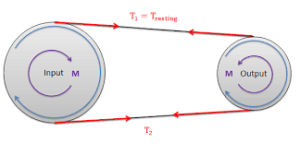The Belt Pull Calculator is a toll that calculates the Pull on the Belt connecting two Pulleys. The calculation of belt pull in a pulley system involves determining the force required to move a belt around a set of pulleys. The belt pull is essential for selecting the appropriate drive system components, including the motor, pulleys, and belts.
Belt Pull Calculator
To calculate belt pull, you need to consider several factors, including:
- Tension in the Belt (T1 and T2): The tension in the belt on the tight side (T1) and the slack side (T2) of the pulley system. These tensions are typically measured in Newtons (N) or Pounds (lbs).
- Coefficient of Friction (μ): The coefficient of friction between the belt and the pulleys’ surfaces. This value is dimensionless.
- Angle of Wrap (θ): The angle at which the belt wraps around the pulley. This angle is measured in radians.

The formula for calculating belt pull in a pulley system is as follows:
Belt Pull (P) = (T1 – T2) × μ + (T1 + T2) × μ × e^(μθ) / (1 – e^(2μθ))
Where:
- P is the belt pull (force) required, typically in Newtons (N) or Pounds (lbs).
- T1 is the initial tension on the tight side of the belt.
- T2 is the initial tension on the slack side of the belt.
- μ is the coefficient of friction between the belt and the pulleys’ surfaces.
- θ is the angle of wrap in radians.
- e is the base of the natural logarithm, approximately equal to 2.71828.
Please note that this formula represents a simplified calculation. In practice, you may need to consider additional factors like dynamic effects, bending losses, and other specific conditions of your pulley system. The calculation can be more complex for multiple pulley systems.
It’s crucial to use accurate values for tension, coefficient of friction, and wrap angle to obtain a reliable belt pull calculation for your specific application. Additionally, consult manufacturer guidelines or engineering handbooks for further assistance and to ensure safety and efficiency in your pulley system design.
Thanks for reading the post Belt Pull Calculator.
Read: Belt Length Calculator